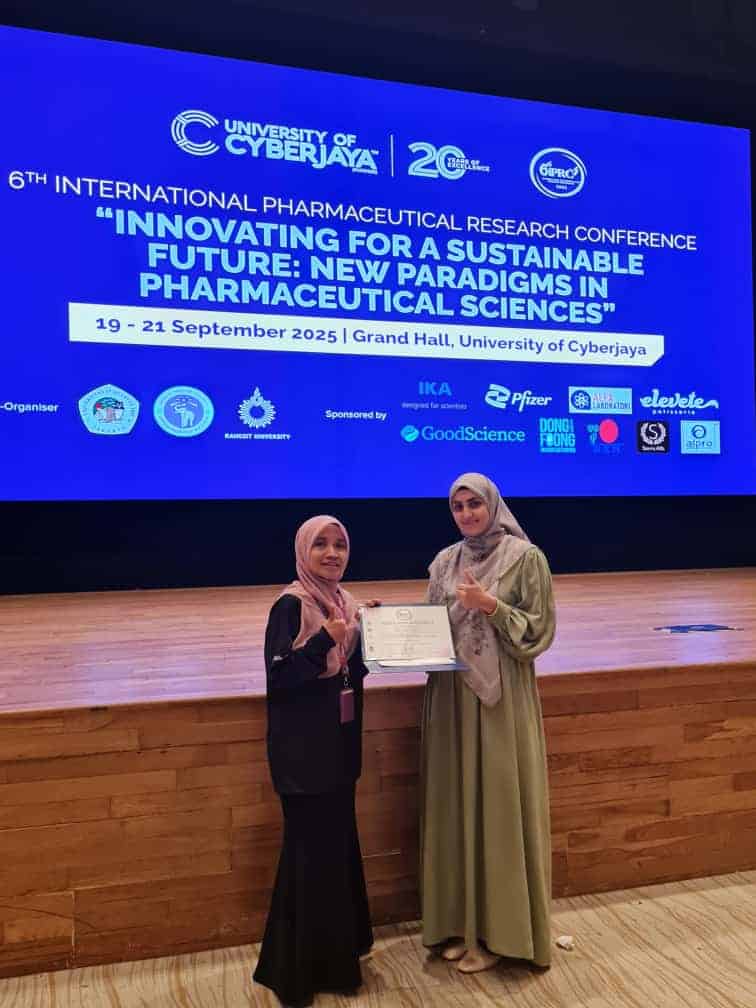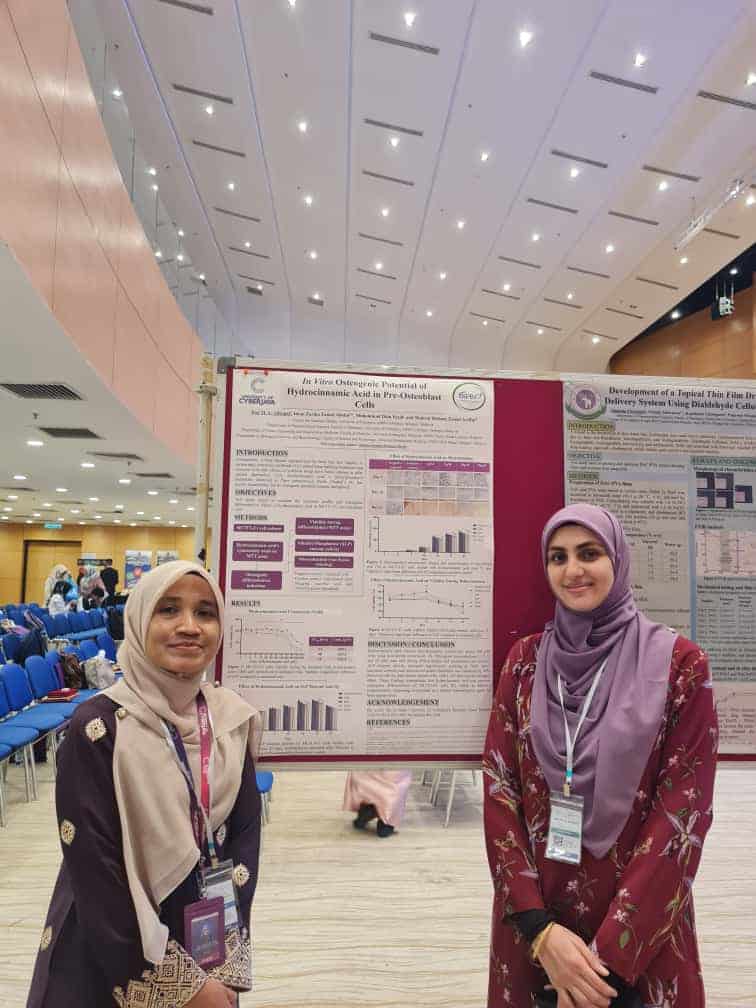
Associate Professor Ts. Dr. Intan Zarina Zainol Abidin
Associate Professor
Research Focus & Scientific Journey
What first inspired your interest in stem cell research, and how has your work evolved since your PhD at UKM?
My interest in stem cell research began during my Master’s studies at Universiti Kebangsaan Malaysia (UKM), where I was fascinated by the body’s remarkable ability to regenerate and repair itself. The concept that undifferentiated cells could be directed to form specific functional tissues captured my curiosity and inspired me to pursue regenerative medicine further. Since then, my work has evolved from studying fundamental stem cell biology to exploring the cellular mechanisms that govern stem cell differentiation. My current focus lies in understanding how natural bioactive compounds influence these processes, with the goal of advancing their therapeutic and regenerative potential.
Your research focuses on adult stem cells and their differentiation potential. What are some of your most exciting findings so far?
One of the most exciting discoveries from my research is that blood-derived stem cells, despite originating from a different lineage, can be induced to differentiate into osteoblasts — the cells responsible for bone formation. This broadens our understanding of cellular plasticity and its potential in regenerative therapy.
Another highlight has been the finding that certain plant-derived extracts, particularly from Piper sarmentosum (locally known as kaduk), can enhance osteoblast differentiation while maintaining cell viability. This opens new possibilities for developing safer, plant-based therapeutic strategies in bone regeneration, and more generally, in regenerative medicine.
You’ve explored how natural products influence stem cell behaviour. How does this intersection between biotechnology and natural medicine benefit tissue regeneration research?
The intersection between natural medicine and biotechnology provides an exciting frontier for innovation. Many natural products contain bioactive phytochemicals that act as signalling molecules capable of influencing stem cell behaviour and directing differentiation.
My studies on Piper sarmentosum have demonstrated how such compounds can enhance osteoblast differentiation, showcasing the therapeutic promise of Malaysia’s rich biodiversity. By integrating molecular assays, gene expression profiling, and advanced imaging, we can scientifically validate traditional resources and uncover their mechanisms at the cellular level — paving the way for safer, cost-effective regenerative therapies.
How does your cytotoxicity analysis using stem cells differ from traditional cancer cell line methods?
Traditional cytotoxicity testing often uses immortalised cancer cell lines, which do not accurately represent normal human physiology. In contrast, my approach employs stem-cell-derived models that more closely mimic real biological conditions. This offers a more predictive and reliable platform for assessing biocompatibility and toxicity of bioactive compounds — particularly useful for developing safer pharmaceutical and cosmetic products.
Research Leadership & Academic Contribution

Since joining UoC in 2016, how have you fostered a strong research culture among your students and colleagues?
Building a strong research culture begins with mentorship, motivation, and collaboration. I encourage my students to think critically, take ownership of their projects, and appreciate the real-world relevance of their research. Regular discussions, progress reviews, and continuous guidance help create an environment of openness and inspiration.
As the former Head of the Research Management Unit, I also worked to strengthen institutional research capacity through workshops on grant writing and publication, as well as initiatives that promote networking and collaboration. I believe strong connections — within and beyond the university — are the foundation of impactful research.
As a reviewer and editor, what qualities do you value most in a strong scientific paper?
A strong paper is original, well-structured, and scientifically rigorous. It should pose a clear research question, present reproducible data, and provide a discussion that meaningfully connects findings to existing knowledge. Clarity, transparency, and integrity are crucial — they ensure the work can be understood, replicated, and built upon by others.
How does your research align with UoC’s vision of creating impactful, community-focused innovations?
My research aligns closely with UoC’s vision and supports the United Nations Sustainable Development Goal (SDG) 3: Good Health and Well-being. By exploring Malaysian natural resources, such as Piper sarmentosum, for regenerative medicine, I aim to develop sustainable, nature-inspired solutions with clinical and commercial value.
This work not only promotes community health and environmental responsibility but also positions UoC as an emerging hub for innovative biotechnology research that benefits society.
Collaboration, Challenges & Vision
Collaboration is key in advancing science. How have interdisciplinary or industry partnerships shaped your work?
Interdisciplinary collaboration has been central to my research journey. I’ve worked alongside cell biologists, biochemists, pharmacologists, and botanists to study molecular mechanisms and biological effects of natural compounds. Collaborations with clinicians have also provided crucial translational insight, ensuring our findings are relevant to patient care. These partnerships have enriched our research quality, led to joint publications, and expanded the impact of our work.
What are the main challenges in conducting stem cell research in Malaysia, and how might they be overcome?
Key challenges include limited funding, infrastructure gaps, and the need for clearer implementation of national stem cell guidelines. Malaysia’s research ecosystem must continue strengthening institutional support, funding accessibility, and long-term policy commitment.
It is also vital to ensure fair funding distribution so researchers from private institutions, including UoC, can contribute fully to national scientific progress. Sustained investment, strong regulatory frameworks, and expanded international collaborations will be crucial in advancing Malaysia’s stem cell research capacity and global competitiveness.
How can universities like UoC strengthen Malaysia’s role in biotechnology and regenerative medicine?
Universities like UoC can play a pivotal role by fostering multidisciplinary collaboration, encouraging translational research, and bridging the gap between laboratory discoveries and real-world applications.
Establishing focused research clusters, specialised postgraduate programmes, and an environment that supports innovation and industry partnerships will be essential. Stronger collaboration with local biotech companies and international research centres will also accelerate capacity-building and enhance Malaysia’s visibility in this fast-evolving field.
What keeps you motivated after more than a decade in academia?
My motivation comes from passion — the thrill of discovery and the satisfaction of contributing to meaningful scientific progress. Seeing our findings published, cited, and expanded upon by others is incredibly fulfilling. Most of all, I’m inspired by my students — witnessing their growth, curiosity, and achievements continually reminds me why I chose this path.
What has been your proudest moment as a researcher and educator?
My proudest moments include seeing my students complete their research, publish their findings, and gain recognition in conferences and competitions. Personally, securing external grants and publishing in high-impact journals are also rewarding. I’m proud to have helped UoC achieve milestones such as full MQA accreditation for the MSc and PhD programmes and improving our MyRA rating from 2 to 3 stars — collective successes that reflect both personal fulfilment and institutional growth.
Finally, what message would you share with young scientists and pharmacy students beginning their research careers?
Stay curious, resilient, and passionate. Research isn’t confined to laboratories — it’s an essential part of being a pharmacist and a healthcare innovator. Pharmacists have the power to discover new drugs, refine therapies, and improve patient care. Every challenge in research brings you closer to understanding and innovation. Embrace the journey with perseverance and purpose, and remember that through research, you can make a genuine difference in people’s lives.


